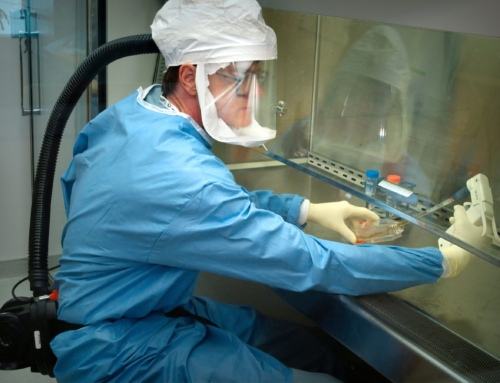How the Jennerator is Shaping Personalized Treatments
March 31, 2023
By Ryan M. Thomas
|
|
|
Last week, I had the opportunity to participate in the Bio-Europe partnering conference in Basel, Switzerland. It was an interesting experience to be in Switzerland during the Credit Suisse bailout and merger with UBS. I would have expected the news to have had more of an impact on participants’ outlook, but I found everyone to continue to be very optimistic about the biotech industry, the need to backfill pipelines, and to advance new platform technologies. |

|
|
At the conference, I was able to meet with several global biotechs and funding agencies to discuss Eyam’s disruptive technologies. Some new opportunities have arisen from the conference including some potential partnerships in the animal health sector – an area that we’ve been interested in expanding into with the right strategic partner. Next week, I’ll be in Washington, D.C. at the World Vaccine Congress and I’ve also been invited to visit Bayer’s new innovation center in Boston next week to discuss and learn about their new partnership initiatives. I’m also excited to share that next week Eyam will initiate our new bioinformatics research center. The research center is the result of Eyam’s partnership with MITACs to further develop the Jennerator Platform and put artificial intelligence to work to design life saving vaccines and therapeutics. This month’s blog will provide an overview of the Jenerator AI Platform, a disruptive tool that Eyam scientists have been optimising for nearly 3 years and has recently been capturing attention from potential strategic partners. We’ll also delve into an array of topics in an interview with one of our research associates, Joanne Fan. Her expertise and unique perspective will provide insights into one of the great minds driving our research and development work. In our Top News of the Month section, we share the latest industry happenings, significant breakthroughs, and notable achievements that are making waves in the world of biotechnology. As we conclude the first quarter of the year, I’ll provide a detailed update on the Eyam’s advances in both science and on the business front of the first quarter of the year in next month’s blog. Updates will include more details about Eyam’s partnership with MITACs to advance research in our new bioinformatics research lab, updates on important milestones, exciting new data coming out of the lab, progress with business development, and share our strategic vision for the rest of 2023. The Jennerator |

|
|
In today’s rapidly advancing world, the marriage of artificial intelligence (AI) and bioinformatics is transforming the landscape of life sciences. Out of all of the areas in which AI will radically change the status quo, biotech represents one of the most promising areas. As we have been developing the exciting potential of these technologies, I’d like to provide you with an overview of how AI is revolutionizing bioinformatics. First, what is bioinformatics? Bioinformatics is the science of storing, analyzing, and interpreting the vast amounts of biological data generated by techniques like DNA sequencing, gene expression analysis, and protein structure prediction. Traditional methods of analyzing these complex data sets have often been time-consuming and labor-intensive, limiting the pace of scientific discoveries. The Jennerator, developed by Eyam scientists, uses machine learning and deep learning algorithms, resulting in a game-changing tool for bioinformatics. By leveraging the power of AI, researchers can now sift through massive data sets, identify patterns, and extract valuable insights at an unprecedented speed and accuracy. The Jennerator Platform has the potential to open new doors for Eyam in fields as diverse as genomics, proteomics, and drug discovery, ultimately leading to more effective and personalized treatments for patients. Some important applications of the Jennerator and AI include:
Cancer vaccines also represent a promising area to leverage the computing power of AI. Some areas that Eyam will look to deploy the Jennerator include:
The Jennerator has the potential to revolutionize the development of vaccines and therapeutics, making them more targeted, personalized, and effective. By harnessing the power of the Jennerator, researchers and clinicians have the potential to better understand the complex interplay between cancer cells and the immune system, potentially leading to the development of innovative therapies to combat devastating diseases. We are excited about our advances in this area, and the launching of our new bioinformatics facility which will allow us to continue to push the boundaries of biotech for the benefit of humanity. |
How the Jennerator is Shaping Personalized Treatments
March 31, 2023
By Ryan M. Thomas
|
|
|
Last week, I had the opportunity to participate in the Bio-Europe partnering conference in Basel, Switzerland. It was an interesting experience to be in Switzerland during the Credit Suisse bailout and merger with UBS. I would have expected the news to have had more of an impact on participants’ outlook, but I found everyone to continue to be very optimistic about the biotech industry, the need to backfill pipelines, and to advance new platform technologies. |
 |
|
At the conference, I was able to meet with several global biotechs and funding agencies to discuss Eyam’s disruptive technologies. Some new opportunities have arisen from the conference including some potential partnerships in the animal health sector – an area that we’ve been interested in expanding into with the right strategic partner. Next week, I’ll be in Washington, D.C. at the World Vaccine Congress and I’ve also been invited to visit Bayer’s new innovation center in Boston next week to discuss and learn about their new partnership initiatives. I’m also excited to share that next week Eyam will initiate our new bioinformatics research center. The research center is the result of Eyam’s partnership with MITACs to further develop the Jennerator Platform and put artificial intelligence to work to design life saving vaccines and therapeutics. This month’s blog will provide an overview of the Jenerator AI Platform, a disruptive tool that Eyam scientists have been optimising for nearly 3 years and has recently been capturing attention from potential strategic partners. We’ll also delve into an array of topics in an interview with one of our research associates, Joanne Fan. Her expertise and unique perspective will provide insights into one of the great minds driving our research and development work. In our Top News of the Month section, we share the latest industry happenings, significant breakthroughs, and notable achievements that are making waves in the world of biotechnology. As we conclude the first quarter of the year, I’ll provide a detailed update on the Eyam’s advances in both science and on the business front of the first quarter of the year in next month’s blog. Updates will include more details about Eyam’s partnership with MITACs to advance research in our new bioinformatics research lab, updates on important milestones, exciting new data coming out of the lab, progress with business development, and share our strategic vision for the rest of 2023. The Jennerator |
 |
|
In today’s rapidly advancing world, the marriage of artificial intelligence (AI) and bioinformatics is transforming the landscape of life sciences. Out of all of the areas in which AI will radically change the status quo, biotech represents one of the most promising areas. As we have been developing the exciting potential of these technologies, I’d like to provide you with an overview of how AI is revolutionizing bioinformatics. First, what is bioinformatics? Bioinformatics is the science of storing, analyzing, and interpreting the vast amounts of biological data generated by techniques like DNA sequencing, gene expression analysis, and protein structure prediction. Traditional methods of analyzing these complex data sets have often been time-consuming and labor-intensive, limiting the pace of scientific discoveries. The Jennerator, developed by Eyam scientists, uses machine learning and deep learning algorithms, resulting in a game-changing tool for bioinformatics. By leveraging the power of AI, researchers can now sift through massive data sets, identify patterns, and extract valuable insights at an unprecedented speed and accuracy. The Jennerator Platform has the potential to open new doors for Eyam in fields as diverse as genomics, proteomics, and drug discovery, ultimately leading to more effective and personalized treatments for patients. Some important applications of the Jennerator and AI include:
Cancer vaccines also represent a promising area to leverage the computing power of AI. Some areas that Eyam will look to deploy the Jennerator include:
The Jennerator has the potential to revolutionize the development of vaccines and therapeutics, making them more targeted, personalized, and effective. By harnessing the power of the Jennerator, researchers and clinicians have the potential to better understand the complex interplay between cancer cells and the immune system, potentially leading to the development of innovative therapies to combat devastating diseases. We are excited about our advances in this area, and the launching of our new bioinformatics facility which will allow us to continue to push the boundaries of biotech for the benefit of humanity. |








